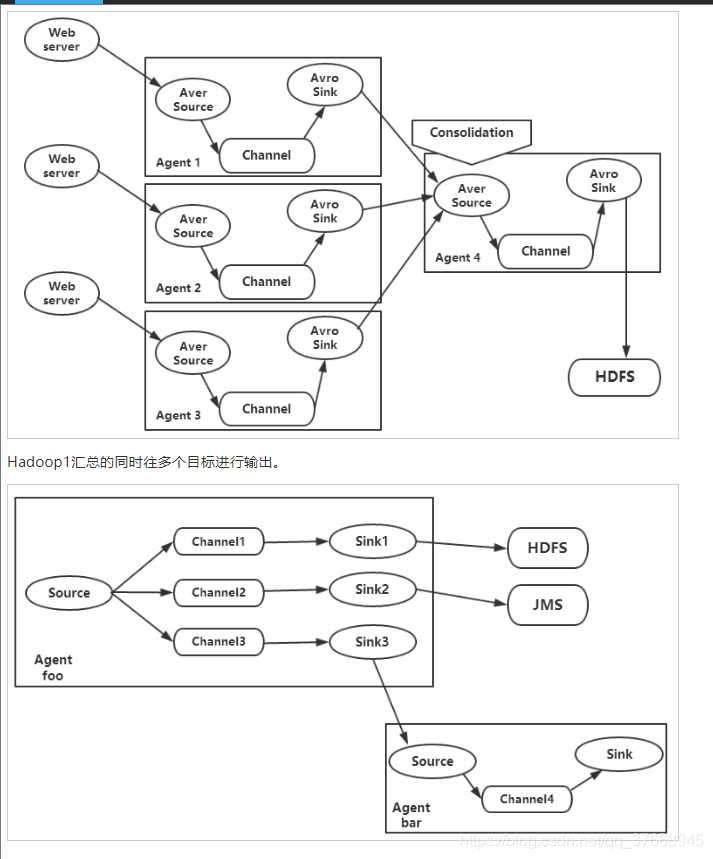-
-
一 安装
--日志收集工具---
应用场景:海量日志采集 聚合 和传输系统
支持日志系统中制定各类数据发送方,用于数据收集,简单处理
,写道各种数据接收方
----安装配置-----
1.修改环境变量。使用vim打开用户环境变量。
sudo vim /etc/profile
追加
#flume config
export FLUME_HOME=/apps/flume
export FLUME_CONF_DIR=$FLUME_HOME/conf
export PATH=$FLUME_HOME/bin:$PATH
使之生效
source /etc/profile
2.配置Flume。切换到/apps/flume/conf目录,并将配置文件flume-env.sh.template重命名为flume-env.sh。编辑
export JAVA_HOME=/apps/java
3.测试
flume-ng version
-
二 故障转移
1.切换到/apps/flume/conf目录下,创建failover_sink.conf文件
2.创建failover_s1.conf
# Name the components on this agent
a2.sources = r1
a2.sinks = k1
a2.channels = c1
# Describe/configure the source
a2.sources.r1.type = avro
a2.sources.r1.channels = c1
a2.sources.r1.bind = localhost
a2.sources.r1.port = 44433
# Describe the sink
a2.sinks.k1.type = logger
a2.sinks.k1.channel = c1
# Use a channel which buffers events in memory
a2.channels.c1.type = memory
a2.channels.c1.capacity = 1000
a2.channels.c1.transactionCapacity = 100
3.创建failover_s2.conf文件
# Name the components on this agent
a3.sources = r1
a3.sinks = k1
a3.channels = c1
# Describe/configure the source
a3.sources.r1.type = avro
a3.sources.r1.channels = c1
a3.sources.r1.bind = localhost
a3.sources.r1.port = 44455
# Describe the sink
a3.sinks.k1.type = logger
a3.sinks.k1.channel = c1
# Use a channel which buffers events in memory
a3.channels.c1.type = memory
a3.channels.c1.capacity = 1000
a3.channels.c1.transactionCapacity = 100
4.在当前目录(/apps/flume/conf)下,执行以下命令启动44433端口
flume-ng agent -c . -f failover_s1.conf -n a2 -Dflume.root.logger=INFO,console
5.另起一个终端模拟器,执行以下命令启动44455端口
flume-ng agent -c . -f failover_s2.conf -n a3 -Dflume.root.logger=INFO,console
6.另启第三个终端模拟器,执行以下命令,启动failover_sink.conf
flume-ng agent -c . -f failover_sink.conf -n a1 -Dflume.root.logger=INFO,console
7.另起第四个终端模拟器,生成测试log
echo "<37>bingo1" | nc localhost 5140
-
三 负载均衡 load_balance
1.切换到/apps/flume/conf目录下,创建load_sink.conf文件
a1.sources = r1
a1.sinks = k1 k2
a1.channels = c1
a1.sinkgroups = g1
a1.sinkgroups.g1.sinks = k1 k2
a1.sinkgroups.g1.processor.type = load_balance
a1.sinkgroups.g1.processor.backoff = true
a1.sinkgroups.g1.processor.selector = round_robin
# Describe/configure the source
a1.sources.r1.type = syslogtcp
a1.sources.r1.port = 5140
a1.sources.r1.host = localhost
a1.sources.r1.channels = c1
# Describe the sink
a1.sinks.k1.type = avro
a1.sinks.k1.channel = c1
a1.sinks.k1.hostname = localhost
a1.sinks.k1.port = 44433
a1.sinks.k2.type = avro
a1.sinks.k2.channel = c1
a1.sinks.k2.hostname = localhost
a1.sinks.k2.port = 44455
# Use a channel which buffers events in memory
a1.channels.c1.type = memory
a1.channels.c1.capacity = 1000
a1.channels.c1.transactionCapacity = 100
2.创建load_s1.conf
#Name the components on this agent
a2.sources = r1
a2.sinks = k1
a2.channels = c1
#Describe/configure the source
a2.sources.r1.type = avro
a2.sources.r1.channels = c1
a2.sources.r1.bind = localhost
a2.sources.r1.port = 44433
#Describe the sink
a2.sinks.k1.type = logger
a2.sinks.k1.channel = c1
#Use a channel which buffers events in memory
a2.channels.c1.type = memory
a2.channels.c1.capacity = 1000
a2.channels.c1.transactionCapacity = 100
3.创建load_s2.conf文件
#Name the components on this agent
a3.sources = r1
a3.sinks = k1
a3.channels = c1
#Describe/configure the source
a3.sources.r1.type = avro
a3.sources.r1.channels = c1
a3.sources.r1.bind = localhost
a3.sources.r1.port = 44455
#Describe the sink
a3.sinks.k1.type = logger
a3.sinks.k1.channel = c1
#Use a channel which buffers events in memory
a3.channels.c1.type = memory
a3.channels.c1.capacity = 1000
a3.channels.c1.transactionCapacity = 100
4.在当前目录(/apps/flume/conf)下,执行以下命令启动44433端口
flume-ng agent -c . -f load_s1.conf -n a2 -Dflume.root.logger=INFO,console
5另起一个终端模拟器,执行以下命令启动44455端口
flume-ng agent -c . -f load_s2.conf -n a3 -Dflume.root.logger=INFO,console
6.另启第三个终端模拟器,执行以下命令,启动load_sink.conf
flume-ng agent -c . -f load_sink.conf -n a1 -Dflume.root.logger=INFO,console
7.另起第四个终端模拟器,生成测试log,注意在测试产生log时,要一行一行地输入,输入太快,容易落到一台机器上
echo "<37>bingo1" | nc localhost 5140
echo "<37>bingo2" | nc localhost 5140
echo "<37>bingo3" | nc localhost 5140
echo "<37>bingo4" | nc localhost 5140
echo "<37>bingo5" | nc localhost 5140
-
Flume配置:Source、Channel、Sink

实验场景1:source:exec,channel:memory,sink:logger,数据是/data/flume2/目录下的goods文件。
场景1是最简单的一个Flume配置,它的结构是由以下几部分组成:首先定义各个组件,其次配置Source的类型为exec,并定义了命令command为tail -n 20 /data/flume2/goods(查看/data/flume2目录下的goods文件里的倒数20行记录),然后配置Channel的类型为memory,Sink的类型为logger,最后将各个组件关联起来(设置Source的Channel为ch,Sink的Channel也为ch)
1.切换到/apps/flume/conf目录下,使用vim编辑conf文件,名为:exec_mem_logger.conf
#定义各个组件
agent1.sources = src
agent1.channels = ch
agent1.sinks = des
#配置source
agent1.sources.src.type = exec
agent1.sources.src.command = tail -n 20 /data/flume2/goods # 这个目录必须提前有 而且文件存在
#配置channel
agent1.channels.ch.type = memory
#配置sink
agent1.sinks.des.type = logger
##下面是把上面设置的组件关联起来(把点用线连起来)
agent1.sources.src.channels = ch
agent1.sinks.des.channel = ch
2.执行命令
flume-ng agent -c /conf -f /apps/flume/conf/exec_mem_logger.conf -n agent1 -Dflume.root.logger=DEBUG,console
按ctrl+c停止flume。
实验场景2:source:exec,channel:memory,sink:hdfs。 场景2相对于场景1,它的Sink类型发生了变化,变成了hdfs型。其结构中定义的各组件,Source配置没有变,在配置Channel时最大容量capacity为100000,通信的最大容量为100,在配置Sink时类型变为hdfs,路径设置为hdfs://localhost:9000/myflume2/exec_mem_hdfs/%Y/%m/%d,里面的%Y/%m/%d代表年月日,数据类型为文本型,写入格式为Text格式,写入hdfs的文件是否新建有几种判断方式:rollInterval表示基于时间判断,单位是秒,当为0时,表示不基于时间判断。rollSize表示基于文件大小判断,单位是B,当为0时表示不基于大小判断,rollCount表示基于写入记录的条数来判断,当为0时,表示不基于条数来判断。idleTimeout表示基于空闲时间来判断,单位是秒,当为0时,代表不基于空闲时间来判断。最后和实验1一样通过设置Source和Sink的Channel都为ch,把Source、Channel和Sink三个组件关联起来。
1.使用vim编辑conf文件,名为:exec_mem_hdfs.conf
#定义各个组件
agent1.sources = src
agent1.channels = ch
agent1.sinks = des
#配置source
agent1.sources.src.type = exec
agent1.sources.src.command = tail -n 20 /data/flume2/goods 此文件必须存在
#配置channel
agent1.channels.ch.type = memory
agent1.channels.ch.keep-alive = 30
agnet1.channels.ch.capacity = 1000000
agent1.channels.ch.transactionCapacity = 100
#配置sink
agent1.sinks.des.type = hdfs
agent1.sinks.des.hdfs.path = hdfs://localhost:9000/myflume2/exec_mem_hdfs/%Y%m%d/
agent1.sinks.des.hdfs.useLocalTimeStamp = true
#设置flume临时文件的前缀为 . 或 _ 在hive加载时,会忽略此文件。
agent1.sinks.des.hdfs.inUsePrefix=_
#设置flume写入文件的前缀是什么
agent1.sinks.des.hdfs.filePrefix = abc
agent1.sinks.des.hdfs.fileType = DataStream
agent1.sinks.des.hdfs.writeFormat = Text
#hdfs创建多久会新建一个文件,0为不基于时间判断,单位为秒
agent1.sinks.des.hdfs.rollInterval = 30
#hdfs写入的文件达到多大时,创建新文件 0为不基于空间大小,单位B
agent1.sinks.des.hdfs.rollSize = 100000
#hdfs有多少条消息记录时,创建文件,0为不基于条数判断
agent1.sinks.des.hdfs.rollCount = 10000
#hdfs空闲多久就新建一个文件,单位秒
agent1.sinks.des.hdfs.idleTimeout = 30
##下面是把上面设置的组件关联起来(把点用线连起来)
agent1.sources.src.channels = ch
agent1.sinks.des.channel = ch
2.执行命令 hadoop 必须启动
flume-ng agent -c /conf -f /apps/flume/conf/exec_mem_hdfs.conf -n agent1 -Dflume.root.logger=DEBUG,console
实验场景3:source:exec channel:file sink:hdfs。
场景3相对于场景2把通道Channel的类型从memory改变为file。其结构在各组件定义,配置Source和设置组件的关联三方面与场景2一样。在配置Channel时把类型变为file型,并设置了检查点目录checkpointDir为/data/flume2/ckdir(用于检查Flume与HDFS是否正常通信),还设置了数据存储目录dataDir为/data/flume2/dataDir。在Sink配置中相对场景2增添了useLocalTimeStamp、inUsePrefix和filePrefix这三个设置。useLocalTimeStamp设置是判断是否开启使用本地时间戳,当设置为true是表示开启。inUsePrefix表示设置临时文件的前缀这里设置为"_",filePrefix表示文件的前缀设置,这里设置为abc。
1.使用vim编辑conf文件,名为:exec_file_hdfs.conf。
#定义各个组件
agent1.sources = src
agent1.channels = ch
agent1.sinks = des
#配置source
agent1.sources.src.type = exec
agent1.sources.src.command = tail -n 20 /data/flume2/goods 此目录文件必须存在
#配置channel
agent1.channels.ch.type = file
agent1.channels.ch.checkpointDir = /data/flume2/ckdir
agent1.channels.ch.dataDirs = /data/flume2/datadir
#配置sink
agent1.sinks.des.type = hdfs
agent1.sinks.des.hdfs.path = hdfs://localhost:9000/myflume2/exec_file_hdfs/%Y%m%d/
agent1.sinks.des.hdfs.useLocalTimeStamp = true
#设置flume临时文件的前缀为 . 或 _ 在hive加载时,会忽略此文件。
agent1.sinks.des.hdfs.inUsePrefix=_
#设置flume写入文件的前缀是什么
agent1.sinks.des.hdfs.filePrefix = abc
agent1.sinks.des.hdfs.fileType = DataStream
agent1.sinks.des.hdfs.writeFormat = Text
#hdfs创建多久会新建一个文件,0为不基于时间判断,单位为秒
agent1.sinks.des.hdfs.rollInterval = 30
#hdfs写入的文件达到多大时,创建新文件 0为不基于空间大小,单位B
agent1.sinks.des.hdfs.rollSize = 100000
#hdfs有多少条消息记录时,创建文件,0为不基于条数判断
agent1.sinks.des.hdfs.rollCount = 10000
#hdfs空闲多久就新建一个文件,单位秒
agent1.sinks.des.hdfs.idleTimeout = 30
##下面是把上面设置的组件关联起来(把点用线连起来)
agent1.sources.src.channels = ch
agent1.sinks.des.channel = ch
2.执行命令
flume-ng agent -c /conf -f /apps/flume/conf/exec_file_hdfs.conf -n agent1 -Dflume.root.logger=DEBUG,console
3.查看Hadoop目录是否生成
实验场景4:source:syslogtcp,channel:memory,sink:logger。
场景4是一个比较简单的Flume组件配置。首先定义了各组件,然后配置Source,Source的类型配置为syslogtcp,监听端口为6868,主机名为localhost,接下来是配置了Channel的类型为memeory,Sink的类型为logger,最后用通过定义Source和Sink的Channel都为ch,来将Source、Channel和Sink三个相关联起来。
1.使用vim编辑conf文件,名为:syslog_mem_logger.conf。
#定义各个组件
agent1.sources = src
agent1.channels = ch
agent1.sinks = des
#配置source
agent1.sources.src.type = syslogtcp
agent1.sources.src.port = 6868
agent1.sources.src.host = localhost
#配置channel
agent1.channels.ch.type = memory
#配置sink
agent1.sinks.des.type = logger
##下面是把上面设置的组件关联起来(把点用线连起来)
agent1.sources.src.channels = ch
agent1.sinks.des.channel = ch
2.执行命令
flume-ng agent -c /conf -f /apps/flume/conf/syslog_mem_logger.conf -n agent1 -Dflume.root.logger=DEBUG,console
3.在另一个终端向6868发送数据
echo "hello can you hear me?" | nc localhost 6868
4.查看flume命令窗口输出
-
Flume多source,多sink组合框架搭建
Flume运行的核心是Agent。它是一个完整的数据收集工具,含有三个核心组件,分别是Source、Channel、Sink。通过这些组件,Event可以从一个地方流向另一个地方。
Source可以接收外部源发送过来的数据。不同的Source可以接受不同的数据格式。
Channel是一个存储地,接收Source的输出,直到有Sink消费掉Channel中的数据。
Sink消费Channel中的数据,将数据推送给外部源或者其他Source。当Sink写入失败后,可以自动重启,不会造成数据丢失,因此很可靠。
在实际生产环境中,Flume允许多个Agent连在一起,形成前后相连的多级跳。Flume有多种组合方式。比如多个Source收集不同格式的数据输出到同一个Sink中,或者一个Source收集的数据输出到多个Sink中去。
现在有三台机器,分别是:Hadoop1,Hadoop2,Hadoop3,以Hadoop1为日志汇总

例子

1.首先检查Hadoop相关进程,是否已经启动。若未启动,切换到/apps/hadoop/sbin目录下,启动Hadoop
2.切换目录到/apps/flume/conf目录下,创建Flume的配置文件。
3.使用vim打开syslog_mem_hdfsandlogger.conf文件。
#定义各个组件
agent1.sources = src
agent1.channels = ch1 ch2
agent1.sinks = des1 des2
#配置source
agent1.sources.src.type = syslogtcp
agent1.sources.src.bind = localhost
agent1.sources.src.port = 6868
#配置channel
agent1.channels.ch1.type = memory
agent1.channels.ch2.type = memory
#配置hdfs sink
agent1.sinks.des1.type = hdfs
agent1.sinks.des1.hdfs.path = hdfs://localhost:9000/myflume4/syslog_mem_hdfsandlogger/
agent1.sinks.des1.hdfs.useLocalTimeStamp = true
#设置flume临时文件的前缀为 . 或 _ 在hive加载时,会忽略此文件。
agent1.sinks.des1.hdfs.inUsePrefix=_
#设置flume写入文件的前缀是什么
agent1.sinks.des1.hdfs.filePrefix = q7
agent1.sinks.des1.hdfs.fileType = DataStream
agent1.sinks.des1.hdfs.writeFormat = Text
#hdfs创建多久会新建一个文件,0为不基于时间判断,单位为秒
agent1.sinks.des1.hdfs.rollInterval = 20
#hdfs写入的文件达到多大时,创建新文件 0为不基于空间大小,单位B
agent1.sinks.des1.hdfs.rollSize = 10
#hdfs有多少条消息记录时,创建文件,0为不基于条数判断
agent1.sinks.des1.hdfs.rollCount = 5
#hdfs空闲多久就新建一个文件,单位秒
agent1.sinks.des1.hdfs.idleTimeout = 20
#配置logger sink
agent1.sinks.des2.type = logger
##下面是把上面设置的组件关联起来(把点用线连起来)
agent1.sources.src.channels = ch1 ch2
agent1.sinks.des1.channel = ch1
agent1.sinks.des2.channel = ch2
4.启动Flume,执行收集工作
flume-ng agent -c /conf -f /apps/flume/conf/syslog_mem_hdfsandlogger.conf -n agent1 -Dflume.root.logger=DEBUG,console
5.新打开一个窗口,执行nc命令,向6868端口发送消息。
echo "hello can you hear me?" | nc localhost 6868
6.查看执行flume命令窗口 的显示结果
7.再来查看HDFS上的输出。
hadoop fs -lsr /
hadoop fs -cat /myflume/syslog_mem_hdfsandlogger/*








 本文详细介绍了Flume的日志收集系统配置方法,包括安装配置、故障转移、负载均衡等场景,以及如何通过组合Source、Channel和Sink实现高效稳定的数据传输。提供了具体的配置示例,如exec_source、syslogtcp_source、memory_channel、hdfs_sink和logger_sink的应用。
本文详细介绍了Flume的日志收集系统配置方法,包括安装配置、故障转移、负载均衡等场景,以及如何通过组合Source、Channel和Sink实现高效稳定的数据传输。提供了具体的配置示例,如exec_source、syslogtcp_source、memory_channel、hdfs_sink和logger_sink的应用。
















 1931
1931

 被折叠的 条评论
为什么被折叠?
被折叠的 条评论
为什么被折叠?








